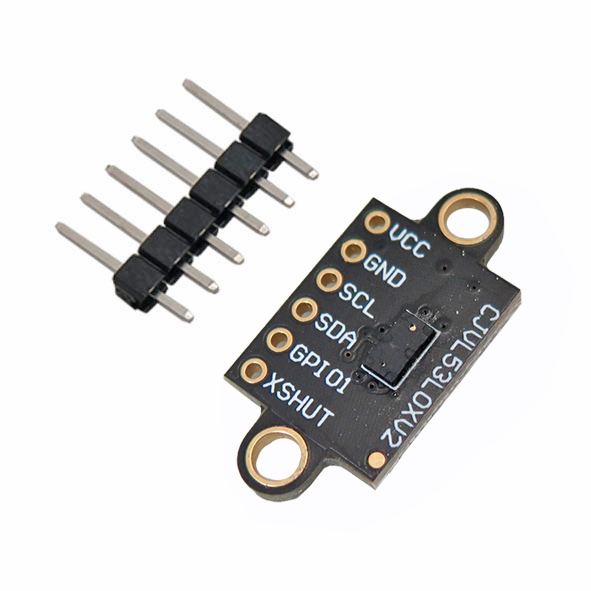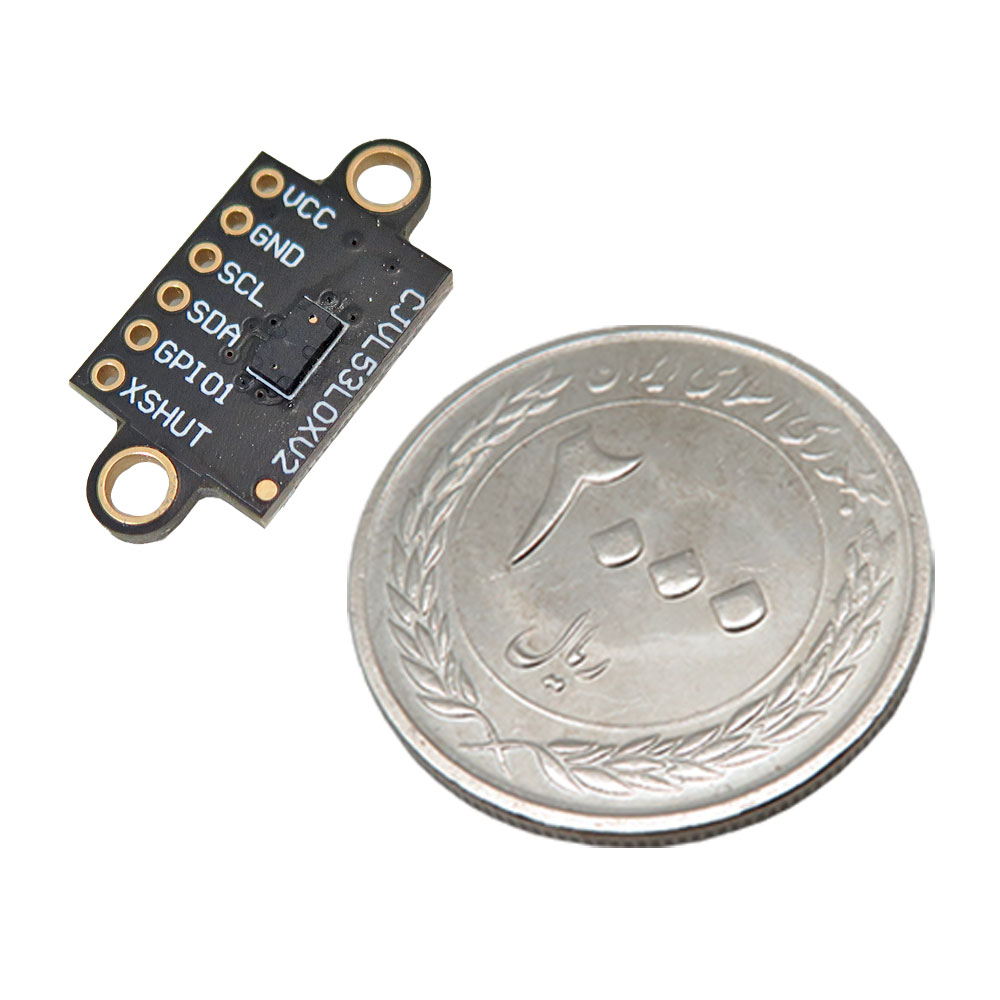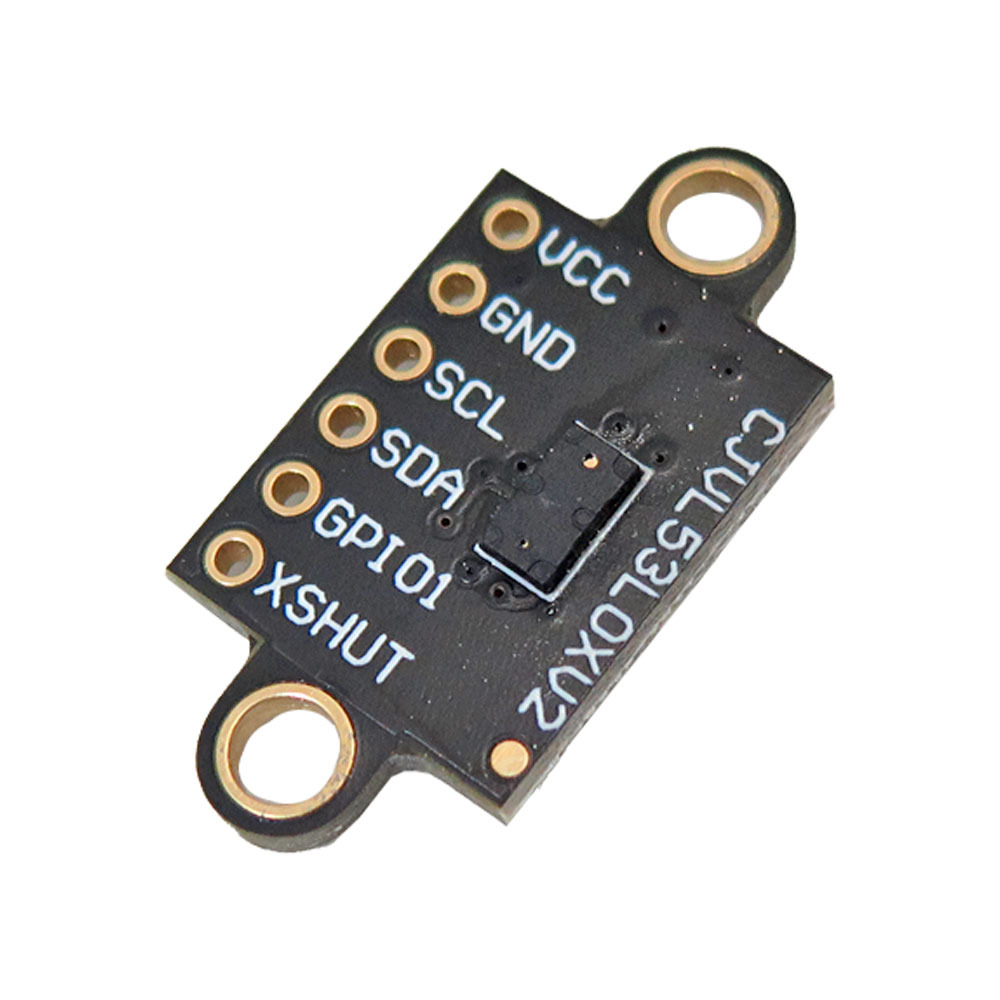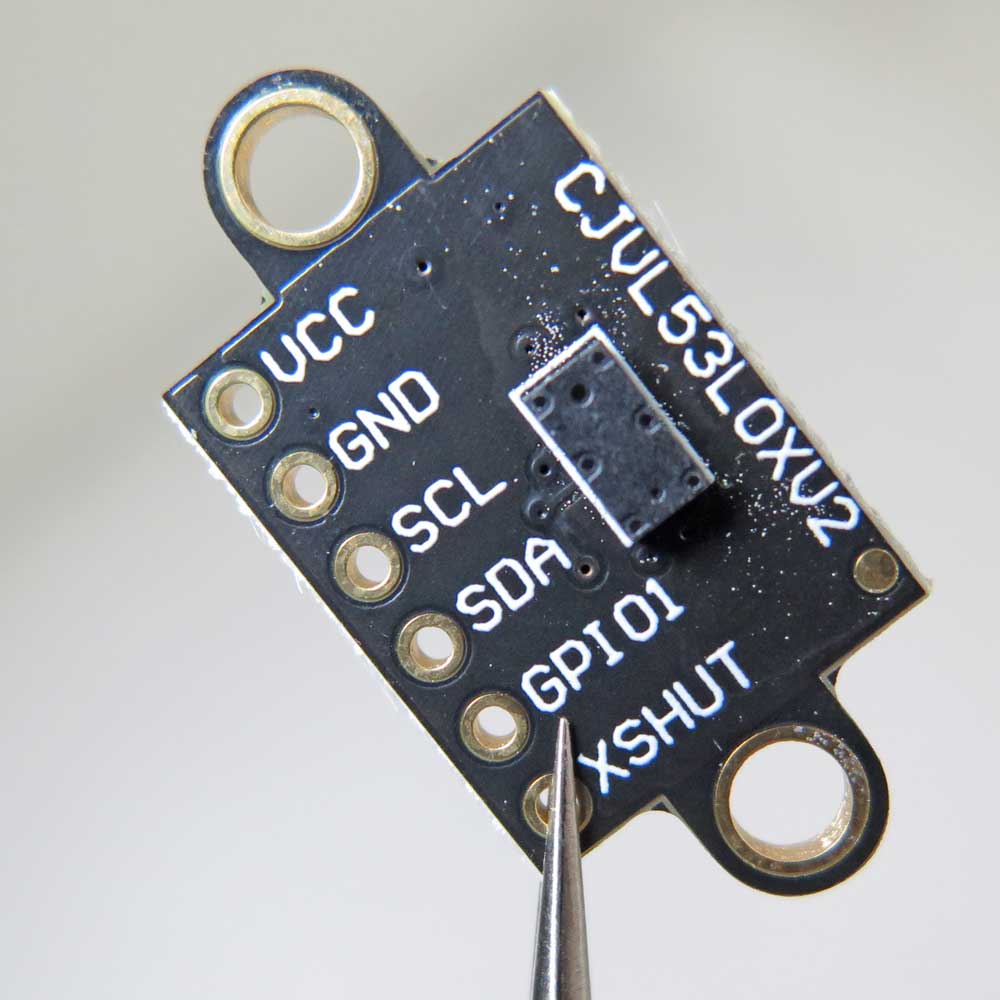127,800 تومان
در حال حاضر موجود نمی باشد
علاقه مندان : 2 نفر
وضعیت : فعال
تعداد مرجوعی : 0
دنبال کنندگان : 2 نفر
قدمت : 8 سال و 6 ماه و 22 روز
وزن : 2 گرم
کل فروش : 154 عدد
تعداد سفارش ها : 91 سفارش
5 از 5.0 با 1 رای
ماژول فاصله سنج لیزری VL53L0X GY-53 محصول CJMCU
ماژول فاصله سنج لیزری VL53L0X برد GY 53 محصول شرکت CJMCU یک سیستم پیشرفته اندازه گیری فاصله مبتنی بر فناوری تایم آف فلایت (ToF) است که تراشه VL53L0X ساخت ST Microelectronics را در برد خود جای داده است. این ماژول با انتشار پالسهای لیزر مادون قرمز در طول موج 940 نانومتر که برای چشم انسان کاملاً نامرئی است ، به همراه فیلترهای فیزیکی مادون قرمز داخلی، توانایی اندازه گیری دقیق و مطمئن فاصله تا 2 متر را با رزولوشن 1 میلی متر فراهم میکند. فناوری FlightSense به کار رفته در این ماژول، با محاسبه زمان بازگشت نور لیزری به سنسور ، امکان تعیین فاصله دقیق هدف را بدون تاثیر زیاد بازتاب سطح آن فراهم میآورد.
این سنسور با دقتی حدود 3± درصد در شرایط بهینه کار میکند و حتی در شرایط محیطی با نور مزاحم تا 10± درصد دقت خود را حفظ میکند. ارتباط با این ماژول از طریق رابط I2C انجام میشود که قابلیت سازگاری با ولتاژهای بین 2.6 تا 5.5 ولت را داراست و به راحتی میتوان آن را به انواع میکروکنترلرها متصل نمود. پایه XSHUT امکان خاموش و روشن کردن سخت افزاری ماژول را فراهم میکند تا مصرف انرژی در پروژههای حساس بهینه شود. منبع تغذیه داخلی رگولاتور 2.8 ولتی را تامین کرده و جریان تا 150 میلی آمپر را برای قطعات جانبی فراهم میآورد. ابعاد کوچک و برد توسعه یافته این ماژول، کار با تراشه بدون پایه LGA را برای مهندسین و علاقهمندان الکترونیک بسیار آسان کرده است.
این ماژول در پروژههای رباتیک ، سیستمهای اندازه گیری فاصله در خانه هوشمند ، اتوماسیون صنعتی و کاربردهای امنیتی که نیاز به دقت بالا و پاسخ سریع دارند ، به عنوان یک گزینه ایدهآل شناخته میشود. برد فاصله سنج VL53L0X این محصول را به یک راهکار کامل برای اندازه گیری دقیق فاصله در محیط های مختلف تبدیل کرده است. همچنین ماژول لیزری سنجش مسافت با بهره گیری از فناوری های روز ، امکان اندازه گیری بدون تداخل نوری و نویز را فراهم میسازد.
این ماژول به عنوان ماژول اندازه گیری مسافت لیزری با برد 2 متر با خروجی I2C ، قابلیت اتصال مستقیم و سریع به میکروکنترلرهای محبوب را دارد و باعث تسهیل توسعه پروژههای هوشمند میشود. در نهایت ، ماژول سنجش فاصله لیزری آردوینو VL53L0X محبوبیت زیادی در بین توسعه دهندگان آردوینو دارد که به دنبال سنسورهای دقیق و قابل اعتماد برای پروژههای خود هستند.
توضیحات پایه ها:
VDD : خروجی رگوله شده 2.8 ولت است. تقریباً 150 میلی آمپر برای تغذیه قطعات خارجی در دسترس است. (اگر بخواهید از رگولاتور داخلی عبور کند ، میتوانید از این پایه به عنوان ورودی 2.8 ولت استفاده کنید در حالی که پایه VIN قطع شده باشد.)
VIN : این پایه ورودی اصلی تغذیه با دامنه 2.6 ولت تا 5.5 ولت است. شیفت ولتاژهای خطوط SCL و SDA ولتاژ خطوط I2C را به این سطح بالا میکشند.
GND : اتصال زمین (0 ولت) برای منبع تغذیه شما است. منبع کنترل I2C شما باید زمین مشترک با این برد داشته باشد.
SDA : خط دیتا I2C با شیفت ولتاژ است - سطح بالا برابر با ولتاژ VIN و سطح پایین برابر با 0 ولت است.
SCL : خط کلاک I2C با شیفت ولتاژ است - سطح بالا برابر با ولتاژ VIN و سطح پایین برابر با 0 ولت است.
XSHUT : این پایه ورودی خاموش کردن فعال در سطح پایین است ؛ برد به طور پیش فرض این پایه را به VDD کشیده تا سنسور فعال باشد. فعال کردن سطح پایین این پایه باعث قرار گرفتن سنسور در حالت آماده به کار سخت افزاری میشود. این ورودی شیفت ولتاژ ندارد.
VIN : این پایه ورودی اصلی تغذیه با دامنه 2.6 ولت تا 5.5 ولت است. شیفت ولتاژهای خطوط SCL و SDA ولتاژ خطوط I2C را به این سطح بالا میکشند.
GND : اتصال زمین (0 ولت) برای منبع تغذیه شما است. منبع کنترل I2C شما باید زمین مشترک با این برد داشته باشد.
SDA : خط دیتا I2C با شیفت ولتاژ است - سطح بالا برابر با ولتاژ VIN و سطح پایین برابر با 0 ولت است.
SCL : خط کلاک I2C با شیفت ولتاژ است - سطح بالا برابر با ولتاژ VIN و سطح پایین برابر با 0 ولت است.
XSHUT : این پایه ورودی خاموش کردن فعال در سطح پایین است ؛ برد به طور پیش فرض این پایه را به VDD کشیده تا سنسور فعال باشد. فعال کردن سطح پایین این پایه باعث قرار گرفتن سنسور در حالت آماده به کار سخت افزاری میشود. این ورودی شیفت ولتاژ ندارد.
نکته آموزشی:
مادون قرمز نزدیک (Near Infrared) بخشی از نور نامرئی برای چشم انسان است که طول موج آن کمی بلندتر از نور قرمز مرئی است و معمولاً بین حدود 700 تا 1400 نانومتر قرار میگیرد. این محدوده به خاطر نفوذپذیری بالا در مواد مختلف و کمترین تداخل با نور محیطی، برای کاربردهای سنجش فاصله و تشخیص بسیار مناسب است. در نتیجه، لیزر با طول موج 940 نانومتر برای چشم انسان نامرئی است و آسیبی به چشم نمیرساند و در عین حال اندازه گیری دقیق فاصله را ممکن میکند.
کاربرد :
- اندازه گیری دقیق فاصله در رباتیک و مسیریابی خودکار
- کاربرد در سیستم های خانه هوشمند برای تشخیص حضور و کنترل دستگاه ها
- استفاده در اتوماسیون صنعتی برای کنترل فاصله قطعات و تجهیزات
مشخصات :
- ولتاژ ورودی : 2.6 تا 5.5 ولت
- ولتاژ کاری ماژول (خروجی رگولاتور) : 2.8 ولت
- جریان مصرفی : حداکثر 150 میلی آمپر
- فناوری اندازه گیری : تایم آف فلایت یا زمان پرواز
- برد اندازه گیری فاصله : تا 2 متر
- دقت اندازه گیری : حدود 1 میلی متر
- رزولوشن اندازه گیری : 1 میلی متر
- طول موج لیزر : 940 نانومتر (مادون قرمز نزدیک ، نامرئی برای چشم انسان)
- دقت اندازه گیری : بین 3± درصد تا 10± درصد بسته به شرایط محیطی
امکانات :
- اندازه گیری دقیق فاصله تا 2 متر با رزولوشن 1 میلی متر
- ارتباط از طریق رابط آی تو سی با میکروکنترلرهای مختلف
- فیلتر داخلی مادون قرمز برای کاهش تاثیر نور محیطی و افزایش دقت اندازه گیری
- کنترل مصرف انرژی و خاموش و روشن کردن سخت افزاری از طریق پایه XSHUT
مستندات:
دریافت دیتاشیت ماژول VL53L0X
Descriptions:
The VL53L0X from ST Microelectronics is a time-of-flight ranging system integrated into a compact module. This board is a carrier for the VL53L0X, so we recommend careful reading of the VL53L0X datasheet (1MB pdf) before using this product.
The VL53L0 uses ST’s FlightSense technology to precisely measure how long it takes for emitted pulses of infrared laser light to reach the nearest object and be reflected back to a detector, so it can be considered a tiny, self-contained lidar system. This time-of-flight (TOF) measurement enables it to accurately determine the absolute distance to a target without the object’s reflectance greatly influencing the measurement. The sensor can report distances of up to 2 m (6.6 ft) with 1 mm resolution, but its effective range and accuracy (noise) depend heavily on ambient conditions and target characteristics like reflectance and size, as well as the sensor configuration. (The sensor’s accuracy is specified to range from ±3% at best to over ±10% in less optimal conditions.)
Ranging measurements are available through the sensor’s I²C (TWI) interface, which is also used to configure sensor settings, and the sensor provides two additional pins: a shutdown input and an interrupt output.
The VL53L0X is a great IC, but its small, leadless, LGA package makes it difficult for the typical student or hobbyist to use. It also operates at a recommended voltage of 2.8 V, which can make interfacing difficult for microcontrollers operating at 3.3 V or 5 V. Our breakout board addresses these issues, making it easier to get started using the sensor, while keeping the overall size as small as possible.
PIN Description:
VDD Regulated 2.8 V output. Almost 150 mA is available to power external components. (If you want to bypass the internal regulator, you can instead use this pin as a 2.8 V input with VIN disconnected.)
VIN This is the main 2.6 V to 5.5 V power supply connection. The SCL and SDA level shifters pull the I²C lines high to this level.
GND The ground (0 V) connection for your power supply. Your I²C control source must also share a common ground with this board.
SDA Level-shifted I²C data line: HIGH is VIN, LOW is 0 V
SCL Level-shifted I²C clock line: HIGH is VIN, LOW is 0 V
XSHUT This pin is an active-low shutdown input; the board pulls it up to VDD to enable the sensor by default. Driving this pin low puts the sensor into hardware standby. This input is not level-shifted.
The VL53L0X from ST Microelectronics is a time-of-flight ranging system integrated into a compact module. This board is a carrier for the VL53L0X, so we recommend careful reading of the VL53L0X datasheet (1MB pdf) before using this product.
The VL53L0 uses ST’s FlightSense technology to precisely measure how long it takes for emitted pulses of infrared laser light to reach the nearest object and be reflected back to a detector, so it can be considered a tiny, self-contained lidar system. This time-of-flight (TOF) measurement enables it to accurately determine the absolute distance to a target without the object’s reflectance greatly influencing the measurement. The sensor can report distances of up to 2 m (6.6 ft) with 1 mm resolution, but its effective range and accuracy (noise) depend heavily on ambient conditions and target characteristics like reflectance and size, as well as the sensor configuration. (The sensor’s accuracy is specified to range from ±3% at best to over ±10% in less optimal conditions.)
Ranging measurements are available through the sensor’s I²C (TWI) interface, which is also used to configure sensor settings, and the sensor provides two additional pins: a shutdown input and an interrupt output.
The VL53L0X is a great IC, but its small, leadless, LGA package makes it difficult for the typical student or hobbyist to use. It also operates at a recommended voltage of 2.8 V, which can make interfacing difficult for microcontrollers operating at 3.3 V or 5 V. Our breakout board addresses these issues, making it easier to get started using the sensor, while keeping the overall size as small as possible.
PIN Description:
VDD Regulated 2.8 V output. Almost 150 mA is available to power external components. (If you want to bypass the internal regulator, you can instead use this pin as a 2.8 V input with VIN disconnected.)
VIN This is the main 2.6 V to 5.5 V power supply connection. The SCL and SDA level shifters pull the I²C lines high to this level.
GND The ground (0 V) connection for your power supply. Your I²C control source must also share a common ground with this board.
SDA Level-shifted I²C data line: HIGH is VIN, LOW is 0 V
SCL Level-shifted I²C clock line: HIGH is VIN, LOW is 0 V
XSHUT This pin is an active-low shutdown input; the board pulls it up to VDD to enable the sensor by default. Driving this pin low puts the sensor into hardware standby. This input is not level-shifted.




